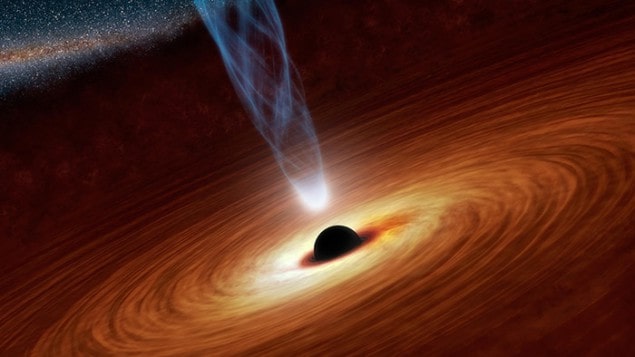
Has an advanced alien civilization built a black-hole-powered particle accelerator to study physics at “Planck-scale” energies? And if such a cosmic collider is lurking in a corner of the universe, could we detect it here on Earth?
Brian Lacki of the Institute for Advanced Studies in Princeton, New Jersey, has done calculations that suggest that if such an accelerator exists, it would produce yotta electron-volt (YeV or 1024 eV) neutrinos that could be detected here on Earth. As a result, Lacki is calling on astronomers involved in the search for extraterrestrial intelligence (SETI) to look for these ultra-high-energy particles. This is supported by SETI expert Paul Davies of Arizona State University, who believes that the search should be expanded beyond the traditional telescope searches.
The nightmare of particle physics is the dream of astronomers searching for extraterrestrials
Brian Lacki, Institute for Advanced Studies
Like humanity, it seems reasonable to assume that an advanced alien civilization would have a keen interest in physics, and would build particle accelerators that reach increasingly higher energies. This energy escalation could be the result of the “nightmare scenario” of particle physics in which there is no new physics at energies between the TeV energies of the Standard Model and the 1028 eV Planck energy (10 XeV) – where the quantum effects of gravity become strong. “The nightmare of particle physics is the dream of astronomers searching for extraterrestrials,” says Lacki.
An important problem facing alien physicists would be that the density of electromagnetic energy needed to reach the Planck scale is so great that the device would be in danger of collapsing into a black hole of its own making. However, Lacki points out that a clever designer could, in principle, get round this problem and “reaching [the] Planck energy is technically allowed, if extremely difficult”.
Not surprisingly, such an accelerator would have to be rather large. Lacki believes that if electric fields are used for acceleration, the device would have to be at least 10 times the radius of the Sun. However, a magnetic synchrotron-type accelerator could be somewhat smaller. As for what materials could be used to make the accelerator, Lacki says that normal materials could not withstand the strong electromagnetic fields. Indeed, one of the few places where such a high energy density could exist is in the vicinity of a black hole, which he argues could be harnessed to create a Planck-scale accelerator.
“Vast amounts of pollution”
Colliding particles at tens of XeVs is only half the battle, however. Lacki calculates that the vast majority of collisions in such a cosmic collider would be of no interest to alien researchers. To get useful information about Planck-scale physics, he reckons that the total collision rate in the accelerator would have to be about 1024 times that of the Large Hadron Collider. “As such, accelerators built to detect Planck events are extremely wasteful and produce vast amounts of ‘pollution’,” explains Lacki.
While much of this pollution would be extremely high-energy particles, that in principle could reach Earth, it is unclear whether they could escape the intense electromagnetic fields within the collider. Furthermore, like colliders here on Earth, the builders of a cosmic machine would probably try to shield the surrounding region from damaging radiation. Indeed, Lacki’s analysis suggests that neutrinos are the only particles that are likely to reach Earth.
These neutrinos would have energies that are a billion or more times greater than the highest energy neutrinos ever detected here on Earth. However, unlike their lower-energy counterparts, these accelerator neutrinos would be much easier to detect because they interact much more strongly with matter. Lacki calculates that the majority of such neutrinos passing through the Earth’s oceans will deposit their energy in the form of a shower of secondary particles. While the oceans are far too murky for physicists to detect the light given off by the showers, Lacki reckons that the sound of a shower could be detected by a network of hydrophones in the water. However, because these neutrinos are expected to be extremely rare, he calculates that about 100,000 hydrophones would be needed to have a chance of detecting the neutrinos.
Whole of the Moon
Another possibility, albeit less sensitive, is to use the Moon as a neutrino detector. Indeed, the NuMoon experiment is currently using a ground-based radio telescope to try to detect showers created when 1020 eV neutrinos smash into the lunar surface.
While the detection of YeV neutrinos would not be proof that an alien accelerator exists – some theories suggest that they could be produced naturally by the decay of a cosmic strings – Lacki says that spotting such high-energy particles would be an important breakthrough in physics.
While Davies is keen to expand SETI, he does identify one important drawback of looking for cosmic colliders. “My main problem is that once the [alien] experiments are done, there would be no need to keep the thing running, so unless there are mega-machines like this popping up all over the place, there would be only transient pulses,” he told physicsworld.com.
Davies believes that it is very difficult for humans today to understand why an advanced civilization would want to build a Planck-scale collider. “Why do it? Perhaps to create a baby universe or some other exotic space–time sculpture,” he speculates. “Why do that? Perhaps because this hypothetical civilization feels it faces a threat of cosmic dimensions. What might that threat be? I have no idea! However, a civilization that knows a million times more than humanity might perceive all sorts of threats of which we are blissfully unaware.”
Lacki’s calculations are described in a preprint on arXiv.
- Paul Davies has written a feature article for Physics World about SETI called “The Eerie Silence”



